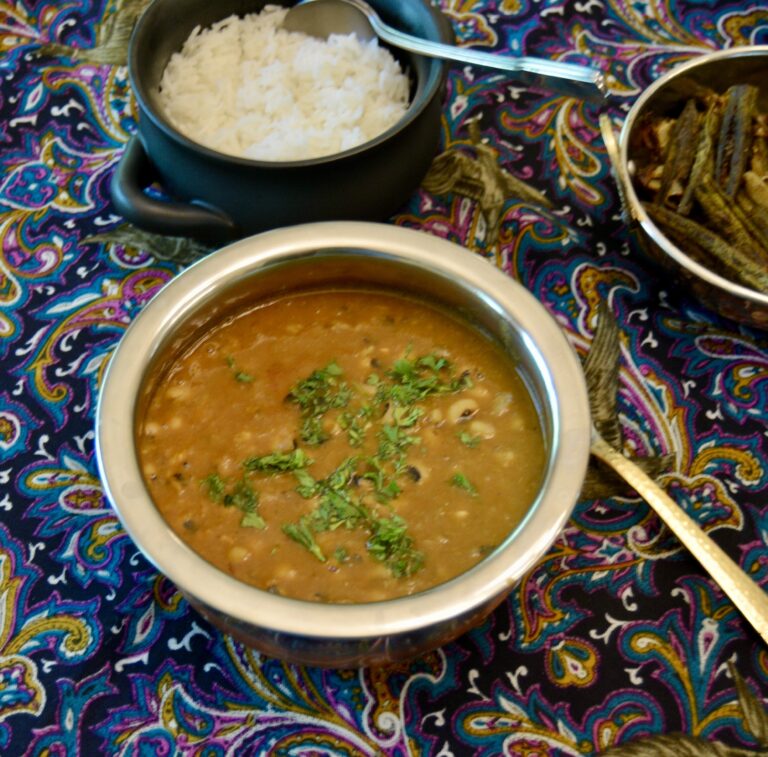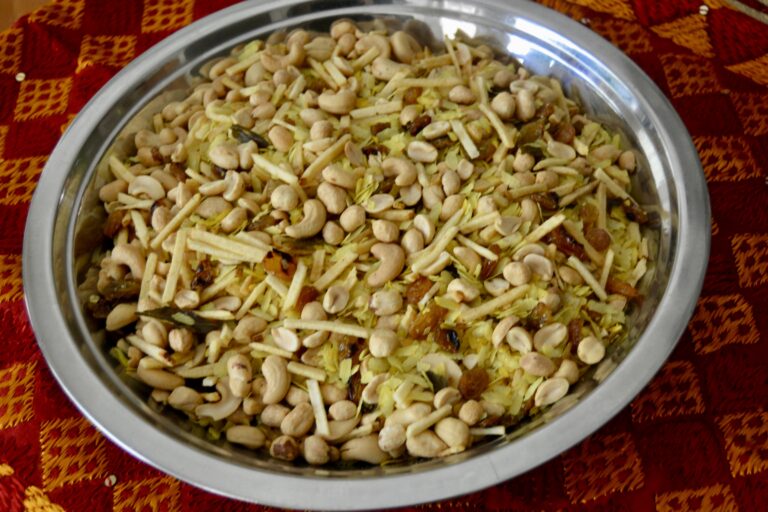It is 3.30 in the morning, and I quietly let myself out of the door so that I won’t wake the sleeping household. It is a freezing winter’s day in New Delhi, and I tug my long black uniform coat snugly around me. The airline transport that just drove up will transport several of us who live in the area to the airline bus depot. We will wait until the other vehicles arrive, and then we will be shuttled to the airport in time for the 5:00 a.m. shift.
We arrive at the bus depot with half an hour to spare. The dhabba that serves at the canteen for the folks who work there is open. Several of us make our way to it. A cup of hot chai is just what we need to warm and wake us up. The owner is ready for us. He has been down this route every morning with the different groups on the morning shift. “Chai?” he asks. We nod, breathing in the wonderful aroma.
 He pours out the hot tea simmering on the chula (mud stove) into the kulhars (handleless terra cotta cup). I watch, fascinated, as he froths the tea by pouring it from one kulhar to the other, keeping about 2 feet of distance between the two kulhars. Surprisingly, he doesn’t lose a drop. He hands me a kulhar. My frozen fingers around the warm kulhar with the steaming hot tea soon warms me up. I am now awake and ready to welcome the incoming passengers and aircraft.
He pours out the hot tea simmering on the chula (mud stove) into the kulhars (handleless terra cotta cup). I watch, fascinated, as he froths the tea by pouring it from one kulhar to the other, keeping about 2 feet of distance between the two kulhars. Surprisingly, he doesn’t lose a drop. He hands me a kulhar. My frozen fingers around the warm kulhar with the steaming hot tea soon warms me up. I am now awake and ready to welcome the incoming passengers and aircraft.
Real Chai has to be aromatic, sweet, and milky, but you can adjust it according to your taste.

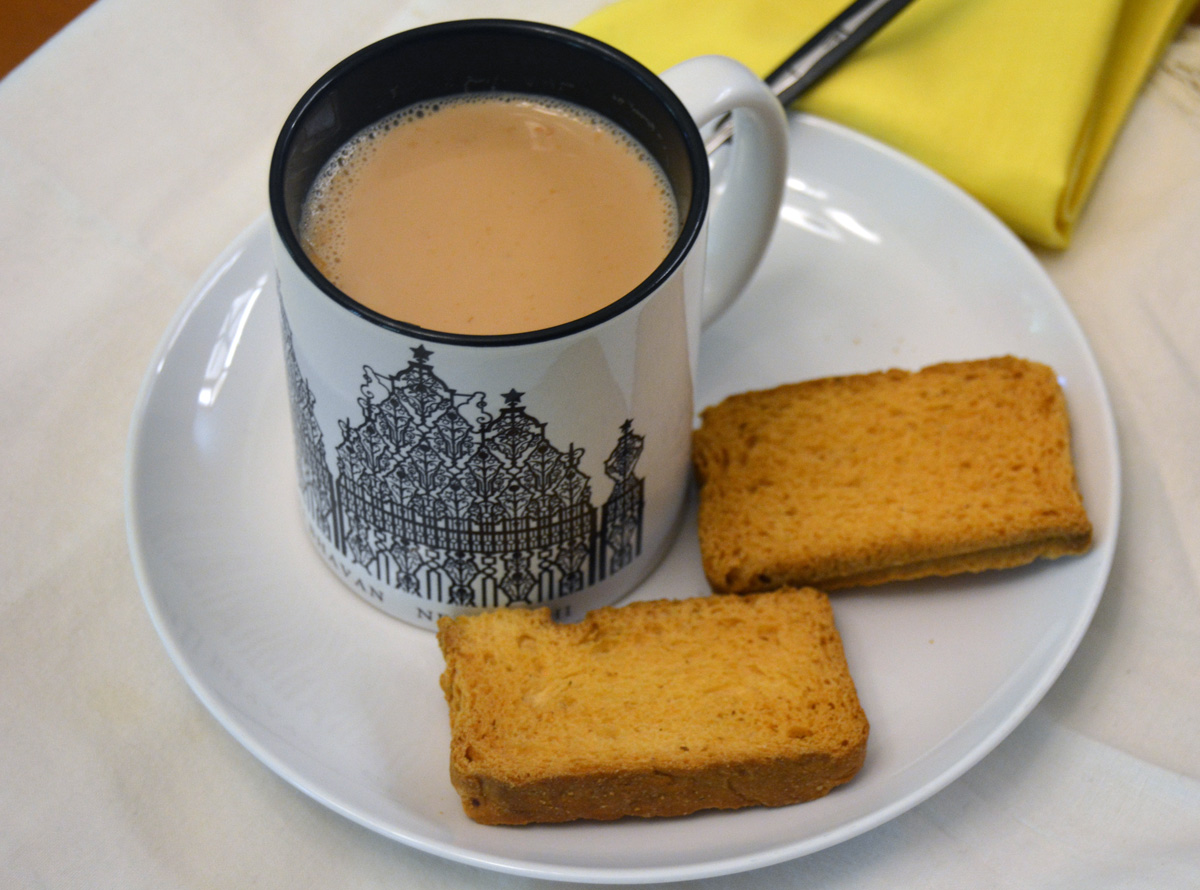
Chai: Indian Aromatic Tea
Ingredients
- 2 cups whole milk (you can also use low fat if you are watching calories, or a vegan milk substitute)
- 1 cup water
- 2 tsp sugar (white or brown, according to your taste)
- 2 teabags black tea (or 2 teaspoons of loose black tealeaves)
- 2 green cardamom
- 1/4 tsp cinnamon powder
- 1/4 tsp clove powder
Instructions
- Crush the cardamom with a rolling pin. The top shell should come off easily. Bow crush the seeds as best you can. It does not have to be absolutely smooth.
- Put all ingredients in a small pot and bring to boil. Lower heat and simmer for 3-4 minutes while you do a taste test. Add more spice accordingly.
- Pour into cups and sprinkle a bit of cinnamon or grate a little nutmeg on top.
- Enjoy!
Notes
Indian Airlines Photo by Sean D’Silva
Kulhar Photo by Inspo on Unsplash
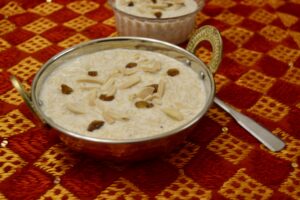 My neighbor has sent over some Seviyan Kheer she has fixed for Eid-al-Fitr, one of the biggest Muslim festivals. It marks the end of the holy month of Ramadan, a time of fasting and prayer. Celebrating religious festivals was special in India due to the diversity of faiths. It was common for neighbors to share the sweets prepared to celebrate their festivals, irrespective of religion. This was especially so in smaller towns than big cities.
My neighbor has sent over some Seviyan Kheer she has fixed for Eid-al-Fitr, one of the biggest Muslim festivals. It marks the end of the holy month of Ramadan, a time of fasting and prayer. Celebrating religious festivals was special in India due to the diversity of faiths. It was common for neighbors to share the sweets prepared to celebrate their festivals, irrespective of religion. This was especially so in smaller towns than big cities.
Seviyan, is made out of roasted vermicelli, milk, sugar, plums, cardamom, and almonds. It is a quick fix and a dish most Indians like to make as a dessert. There is also Sweet Seviyan, a dish that does not involve milk.

Seviyan Kheer (Vermicelli Pudding)
Ingredients
- 1 cup roasted vermicelli/seviyan (available at Indian grocery stores—see notes )
- 5 cups milk
- ½ cup sugar
- ¼ cup roasted slivered almonds (save some for garnish)
- ¼ cup golden raisins (save some for garnish)
- ⅛ tsp green cardamom powder (or take 2 cardamom pods and crush it in a mortar pestle till coarsely powdered—remove husks)
- 2 drops Kewra water (optional—available at Indian grocery stores)
Instructions
- Break the roasted seviyan into several bits.
- Heat a heavy-bottomed large saucepan on medium heat and add the tablespoon of butter and the seviyan. Stir for about 1 minute.
- Pour it onto a plate and set aside.
- Return the pan to the stove, and on medium heat, add the milk and bring it to a boil—about 10 minutes.
- Once it boils, reduce the heat to medium-low.
- Add the crushed cardamom and let it simmer uncovered for about 15 minutes until the milk is reduced slightly. Stir often, scraping the sides and bottom to avoid the milk sticking and burning.
- Add the roasted vermicelli and let it cook for about 2 minutes.
- Add the sugar and stir to dissolve. About 3 minutes.
- Do a taste test and add more sugar if desired.
- Add almonds, golden raisins, cardamom powder, and kewra drops.
- Simmer for another 5 minutes,stirring gently, until the pudding mix is creamy.
- Pour into a serving dish and garnish with reserved almonds and raisins.
- You can serve Seviyan warm or chilled.
Notes
Our second-youngest sibling is a picky eater. Not only that, she takes forever to finish her food! I recall a day when we sat chatting around the dining table. Aunt Dolly was visiting. She watched while my sister ate a banana. Finally, she said, “For goodness sake, finish that thing, you have taken 45 minutes already!” We all laughed at her exasperation! Today, I am fixing her lobia curry, one of the few lentils she enjoys.
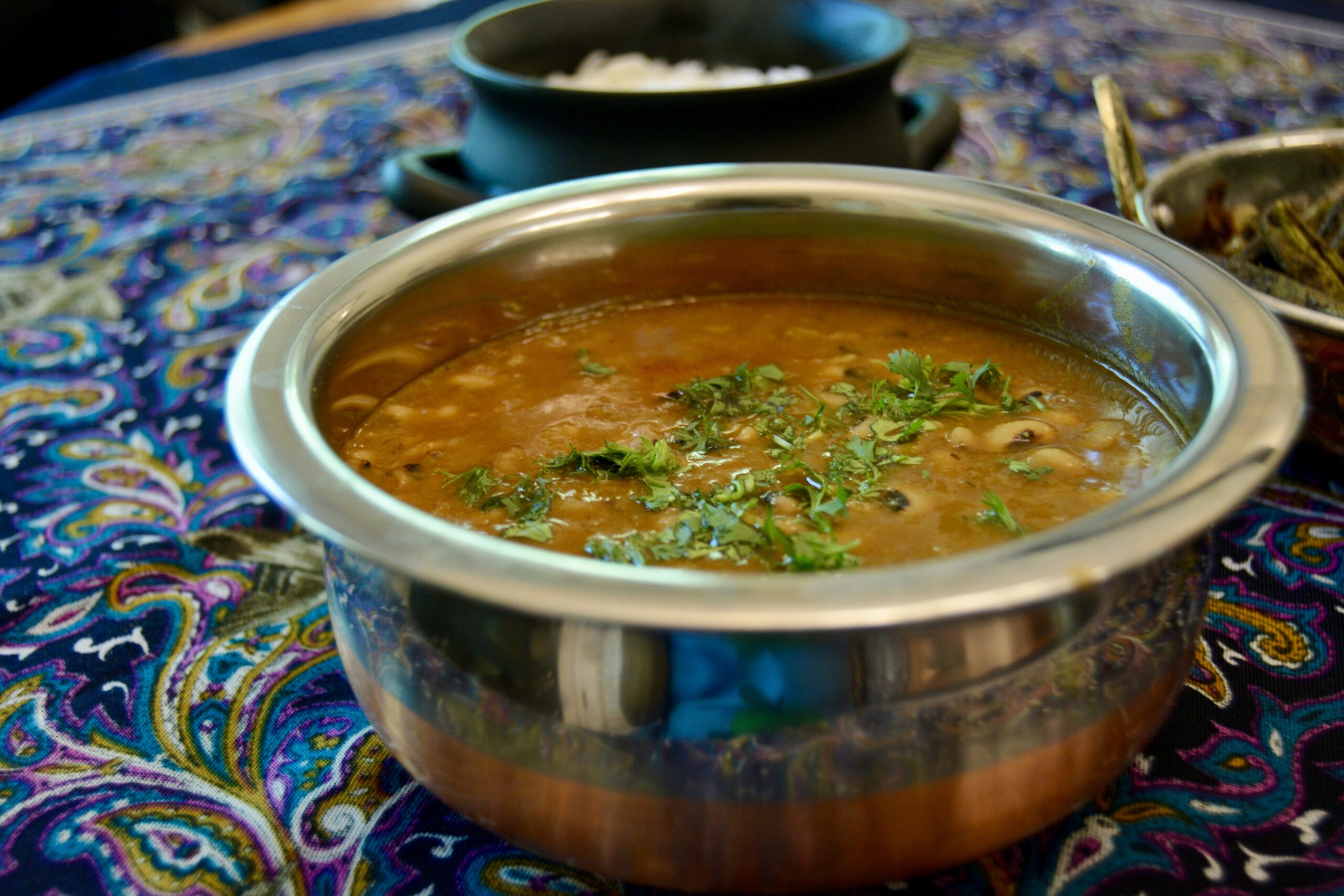
Lobia Lentil Curry (Black-Eyed Peas)
Ingredients
- 2 cups dried black-eyed peas
- 2½ tbsp cooking oil
- 2 medium onions (peeled and chopped very fine)
- 1 medium green Serrano chili (optional)
- 2 tbsp tomato paste ( or 1 8 oz can tomato sauce)
- 1 tbsp fresh ginger paste (or bottled)
- 1 tbsp fresh garlic paste (or bottled)
- 1 tsp cumin powder
- ½ tsp tumeric powder
- ¼ tsp red chili powder (more or less, according to your taste)
- 4-6 cups water (or more, depending on the amount of gravy you want)
- 2 tbsp chopped cilantro (fresh coriander leaves, for garnish)
Whole Spices
- 1 large black cardamom ( )
- 2 bay leaves
- 2-3 cloves
- 4 peppercorns
Instructions
To Prepare
- Pick and clean the black-eyed peas of any grit. Rinse well 4 times. Cover with 5 cups of water and soak overnight. When ready to cook, rinse through a sieve.
To Cook
- Heat oil in 4-6 quart cooking pot over medium heat. Add the whole spices, wait 30 seconds, stirring once or twice, and then add the onions. Sauté till ¾ brown, about 5-8 minutes.
- Add the rest of the masala, garlic, and ginger. You can mix these all together with a little water before adding them to the pot. Stir for 2 minutes, scraping the bottom of the pan to ensure the ginger, garlic, and masalas don't stick and burn.
- Add the tomatoes and cook for another 2 minutes. Then add the black-eyed peas and water. Cover and cook until tender. Approximately 35-40 mins. If the water starts to dry up during the cooking process, add a little more hot water.
- When nearly done, use the back of your ladle to mash some peas against the side of the pot to make a thicker gravy. Cook for another 3-5minutes.
- Transfer to a serving bowl and garnish with the chopped cilantro. It tastes good with plain boiled rice or any Indian-style pilaf.
Simple Tadka / Tempering
- A simpler tempering can be done with just: 1 medium onion chopped, 1 large tomato chopped ½ tsp turmeric 1 tsp cumin powder Chili powder to your taste. Sauté the onions and tomatoes, and then stir in the powders and pour the mixture into the boiled beans.
Notes
It is the winter holidays, and school is out. Dad is stationed in Calcutta. Dad and Mom’s social life is pretty hectic. Nanny watches us like a hawk when they are out for cocktails, dinner, or at the club.
Daniel, our cook, is prepping for a pre-Christmas party. Some of us, older siblings, have helped him beat the eggs for the vanilla cake and are fascinated as he slowly places the cake in a large round tin half filled with sand sitting on top of the sigiri (a clay stove fueled with coal).
Daniel tests to see if the sand is hot enough. He then slowly sets the cake pan in the middle of the drum on top of the sand. He then covers it with a fitted lid and places hot coal on top. This way of cooking was the method that Daniel preferred to use to bake our cakes, and they always turned out delicious.
In those days, other than clubs, restaurants, and military dining halls, ovens (other than tandooris) were not widely used in Indian homes since most Indian cuisine did not require it. The local bakeries, schooled under the British Raj with recipes handed down for generations, baked some of the best pastries and cakes I have ever eaten. They would also oblige families by baking any homemade cakes in their ovens upon request—and for a fee, of course!
With time, stovetop and small electric ovens found their way into homes. Baking ovens have now become a necessity in most urban Indian homes.
I used to bake cakes from scratch, but when I moved to the US, I took the easy way out and used packaged cake mixes. The one that I like best is the Super Moist Yellow Cake Mix. My twin was in town one holiday season when I prepared to bake the cake. She suggested I substitute some water with rum and fix a rum cake.
The Rum Cake became a big hit at potlucks, church gatherings, dinners, and as baked gifts to my neighbors for Christmas. Thank you, Twin!
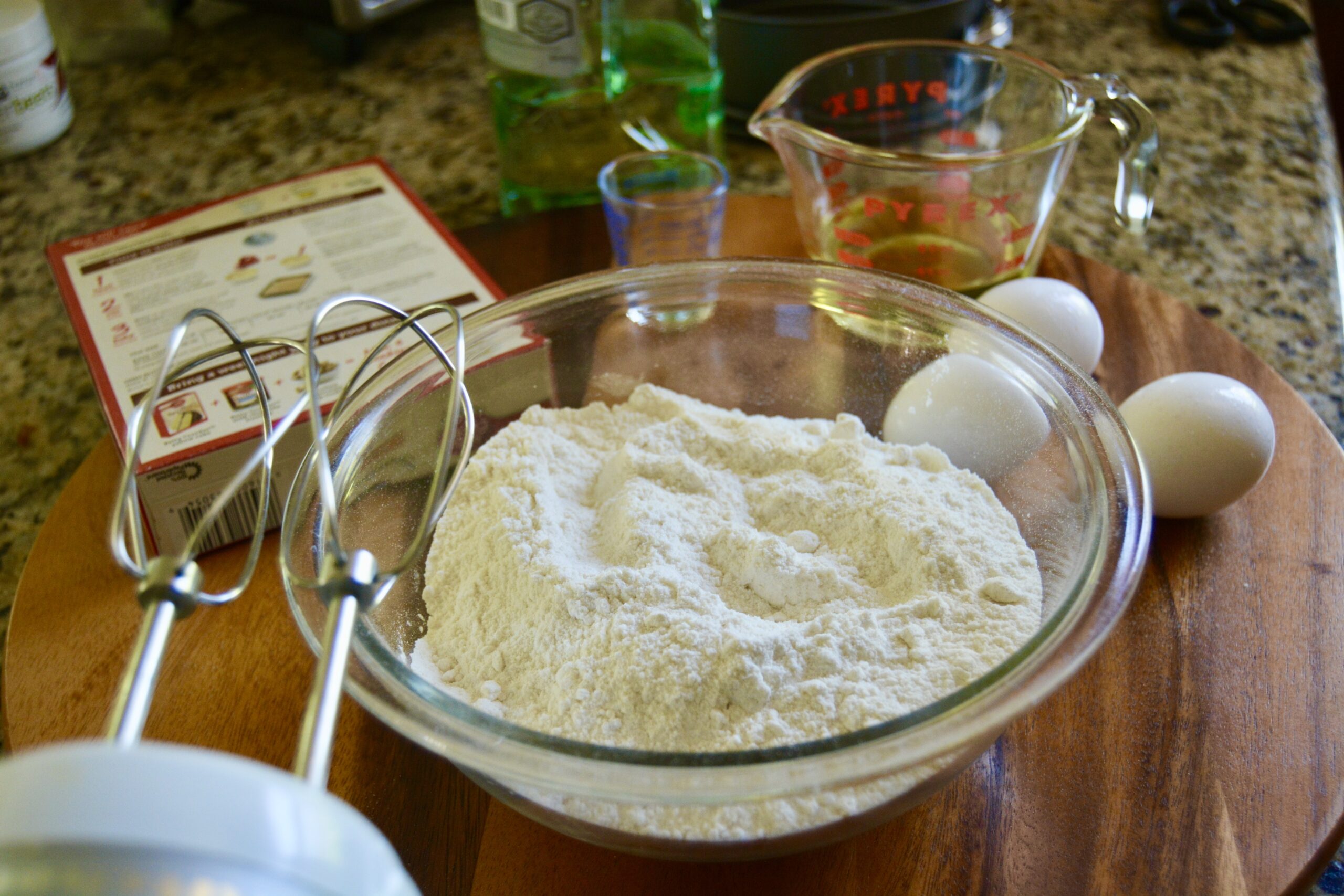
Rum Cake
Ingredients
- 1 box yellow cake mix (I like Betty Crocker's Super Moist Yellow Cake or Duncan Hines Classic Yellow Deliciously Moist Cake)
- ½ cup vegetable oil (Please check the instructions on box to see the exact amount of oil needed as it may differ)
- 3 eggs
- ¾ cup water
- ¼ cup rum (Ensure it is an excellent strong rum, white or dark)
- powdered sugar (for dusting the cake - more or less, per your taste)
- dash cake sprinkles
Instructions
Yellow Cake
- Prepare according to the instructions on the box.
- Keep an eye on the cake towards the end to ensure it does not dry out. I generally stick a bamboo skewer into it 5 minutes before the bake time. If it comes out clean, I remove it from the oven and allow it to cool.
- Once cool, dust it with the powdered sugar and decorate the top with sprinkles.
Notes
Buttercream Frosting
Check Wilton's easy recipe. Click the link here: Best Homemade Vanilla Buttercream Frosting.Buttercream Rum Drizzle
1 cup Buttercream Frosting ¼ cup rum Heat the cup of buttercream frosting in a saucepan on low heat. When it starts to bubble, add the rum. Be careful as the rum makes the frosting bubble up. Stir and drizzle it over the cooled cake. When I prepare the drizzle, I take a cup of store-bought frosting and zap it in the microwave for less than a minute. Remove from the microwave, and add the rum. Stir and drizzle the mixture over the cake. I do prefer the light sugar dusting!Some salads are a meal in themselves. Here is a salad Mama used to fix during Christmas instead of boiled vegetables and béchamel sauce. It is a blend of diced boiled vegetables, boiled eggs, and raw apples served chilled.
The salad was created in the 18th century by Lucien Olivier, a Russian chef of Belgian-French descent who owned a restaurant in the early 1860s in Moscow. It was called Olivier Salad or Russian salad. Variations of the salad spread all over Eastern Europe and eventually worldwide.
This recipe is one version of it. Please read the notes before you start.

Olivier Salad / Russian Salad
Ingredients
- 6 hard-boiled eggs (peeled and cut into medium cubes - ½ inch more or less)
- 1½ cups boiled peas and carrots (cooked al dente - I use a 12 oz mixed frozen package)
- 2 large boiled potatoes (peeled and cut into cubes - about 3 cups)
- 2 medium Granny Smith apples (peeled and cut into cubes)
- 1¼ cup mayonnaise (homemade or store-bought, your choice)
- ⅛ tsp salt
- ⅛ tsp black or white ground pepper
- 1 tsp lemon juice
- 1 can sliced beetroot (for garnish - you can also boil a fresh beetroot, al dente, peel, and use)
Instructions
- When all the boiled ingredients are cooled, transfer them to a large bowl, except for the sliced beetroot.
- Add the mayonnaise, sprinkle with pepper and salt, then gently mix all the ingredients until well coated.
- Pour into a serving dish.
- Garnish the salad with the sliced beetroot any way you like. I like to circle them in the corners of the salad so that the beetroot does not stain the salad before it is set on the table.
Notes
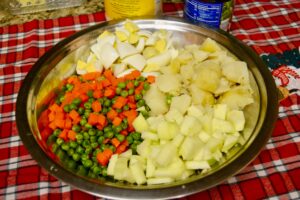 The eggs and potatoes should be boiled separately.
If you are using separate packets of frozen peas or carrots or fresh peeled and diced carrots and peas, boil them separately (or zap them in the microwave).
The potatoes, apples, and eggs should be about the same-sized cubes.
The vegetables should be at room temperature or chilled before tossing the salad. This step can also be done a day ahead and refrigerated.
Transfer all the boiled vegetables, except the beetroot, into a large bowl, and refrigerate until ready to serve. Then garnish with the sliced beetroot.
The eggs and potatoes should be boiled separately.
If you are using separate packets of frozen peas or carrots or fresh peeled and diced carrots and peas, boil them separately (or zap them in the microwave).
The potatoes, apples, and eggs should be about the same-sized cubes.
The vegetables should be at room temperature or chilled before tossing the salad. This step can also be done a day ahead and refrigerated.
Transfer all the boiled vegetables, except the beetroot, into a large bowl, and refrigerate until ready to serve. Then garnish with the sliced beetroot.
Christmas was always a great time for us. Mama and Dad always made it a very special and memorable celebration for us. Two weeks before Christmas, Mama would start preparing the “pakwan” (translated loosely means goodies, sweet and savory), that was prepared for festivals.
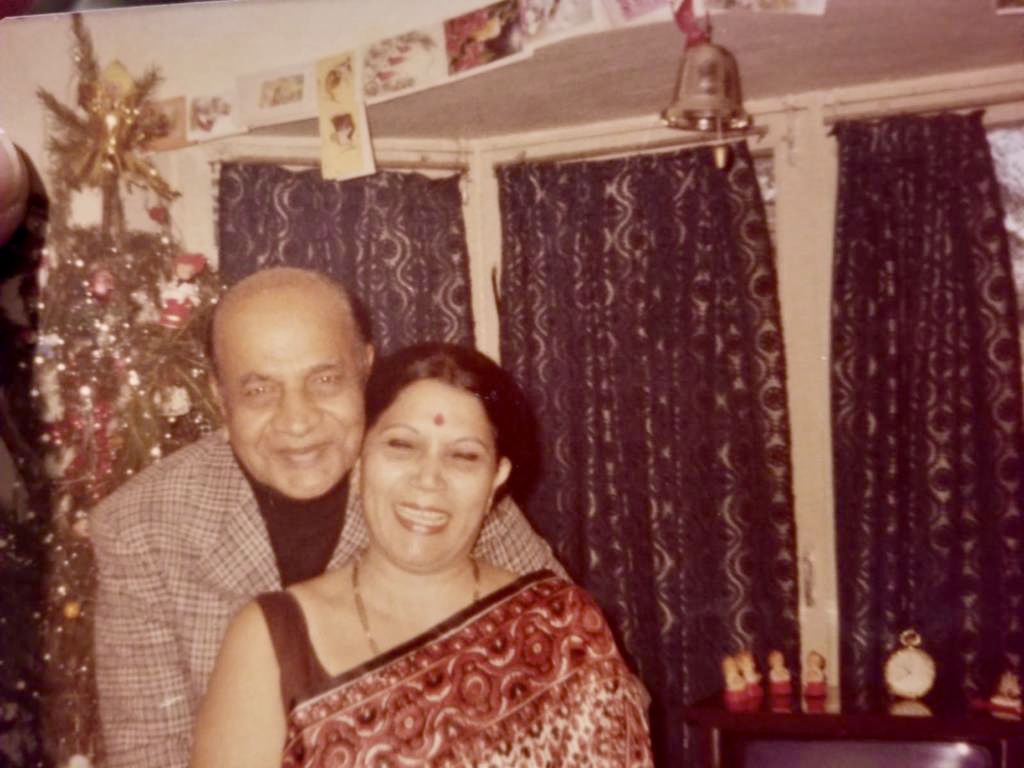
Christmas Day was an open house for family, friends, and acquaintances. Members of Dad’s regiment would come in a steady stream to wish us a “Happy Christmas.” Hot tea and coffee (with milk and sugar, please), cold drinks, and pakwan would be served nonstop from 10:00 a.m. to 6:00 p.m.
When we were old enough to handle a heavy-laden tray, several of us older siblings would be called on to help in the serving. In India it does not matter what religion you are, you celebrate with your friends in their festivals. Needless to say, with all the many religious festivals, we were celebrating every month!!
Chivda was a favorite with us. When you look at the ingredients below you can understand why. Mama always fixed it at home, as she did not like to get it from the store.
Today, you can buy store-bought packets but I still enjoy the homemade version as I can temper the chili heat to my palate!
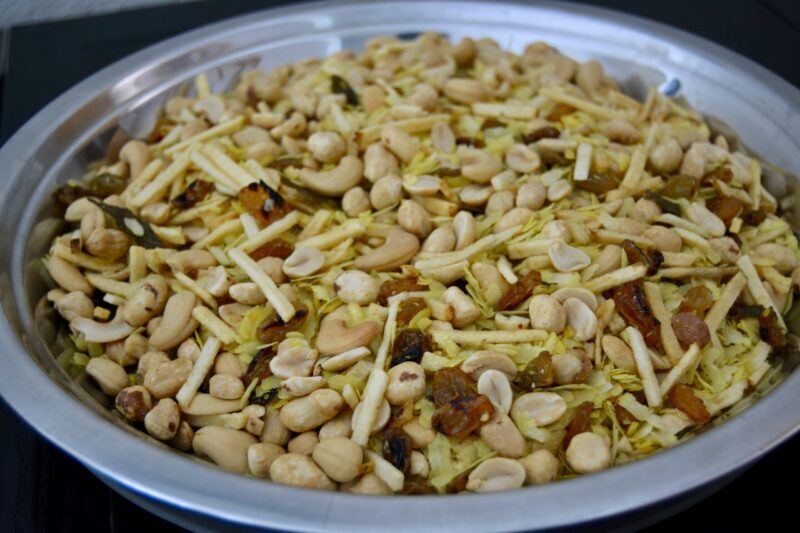
Chivda (All in One Savory Snack)
Ingredients
- 16 oz salted cocktail peanuts
- 18 oz salted cashew nuts (or add more to your taste)
- 16 oz salted shoestring potatoes (available in most grocery stores)
- 1 cup golden raisins
- 3 cups thick poha (flat beaten rice, available at most Indian grocery stores)
- 2 green chilies (chopped into small bits)
- 15-20 curry patta (Indian curry leaves, available at most Indian grocery stores)
- ¼ tsp turmeric powder
- ½ tsp chili powder (optional, more or less to your taste)
- 3 tbsp cooking oil (if deep frying, you'll about 2-3 cups of oil)
Instructions
- On medium heat, heat a tablespoon of the oil in a deep skillet or wok (at least 12-14" in size).
- Add the chopped green chilies and curry patta. Stir for about 30-40 seconds until the curry patta and green chilies darken. Turn off the heat. Remove and place on a paper towel to drain.
- Add another tablespoon of oil to the skillet. Heat on medium-high and add the raisins. Stir for about 1 minute until the raisins plump out. Do not burn. Turn off the heat, remove the raisins, and drain them on a paper towel.
- In the same skillet, on medium heat, put another tablespoon of oil and add the turmeric. Stir 15 seconds, then add the beaten rice. Let sauté, stirring occasionally, for approximately 10 minutes. The flakes will get a little crunchy, but they do not have to be browned.
- Once the poha is lightly browned, turn off the heat. Now add all the other ingredients. Salt is not needed since there is enough in the other salted ingredients.
- If you want it spicy, you can add some chili powder or chili flakes to suit your taste. Stir carefully so as not to break up the poha. Mix all ingredients well.
- Let cool and store in airtight containers.Great as a tea time snack or if you were getting an attack of the munchies! These do not last long enough in my house to give you shelf time. If I had to guess, I would say at least a month.



